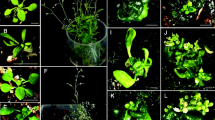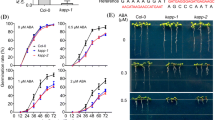Abstract
The GSK3/Shaggy family of serine/threonine protein kinases is involved in a series of biological processes in animals, plants and yeast [Charrier et al. (2002) Plant Physiol 130:577–590; Jope and Johnson (2004) Trends Biochem Sci 29:95–102; Li and Nam (2002) Science 295:1299–1301; Piao et al. (2001) Plant J 27:305–314]. In Arabidopsis thaliana, out of the 10 members of the GSK3/Shaggy-like gene family (AtSKs), a biological function has been assigned to only 1 member (AtSK2-1) by mutation. In the present work, a study was undertaken to elucidate the function of AtSK3-2. We have generated mutated versions of the A. thaliana Shaggy-like kinase 3-2 (AtSK3-2), in which Lys167 and Arg178, respectively homologus to Lys85 and Arg96 of the mammal GSK3β, were modified into Ala by site-directed mutagenesis. In vitro kinase activity assays of the mutated recombinant protein AtSK3-2-R178A showed that the “primed activity” of the mutated kinase was reduced by 90% while the “non-primed” activity was only 20% reduced compared to the wild-type protein kinase. However, the mutant protein AtSK3-2-K167A showed no activity. Arabidopsis transgenic lines over-expressing AtSK3-2-R178A displayed smaller floral organs, namely pedicels, sepals and petals. Conversely, over-expression of both the wild-type AtSK3-2 protein and the AtSK3-2-K167A mutated version, displayed no altered morphogenesis. Scanning electron microscopic analyses of the AtSK3-2-R178A transgenic plants clearly showed a reduced cell size in flower organs, in which quantitative RT-PCR expression analyses of cell wall expansion enzymes showed reduced transcript levels of three xyloglucan endotransglycosylases (XET), namely XTH22 (TCH4), XTH23 (XTR6) and XTH30 (XTR4). Our data show that AtSK3-2 plays an important role in the control of cell elongation in flower development.








Similar content being viewed by others
References
Biondi RM, Nebreda AR (2003) Signalling specificity of Ser/Thr protein kinases through docking-site-mediated interactions. Biochem J 372(Pt 1):1–13
Charrier B, Champion A, Henry Y, Kreis M (2002) Expression profiling of the whole Arabidopsis shaggy-like kinase multigene family by real-time reverse transcriptase polymerase chain reaction. Plant Physiol 130:577–590
Cho J-H, Johnson GVW (2003) Glycogen synthase kinase-3-beta phosphorylates Tau at both primed and unprimed sites. J Biol Chem 278:187–193
Choe S, Schmitz RJ, Fujioka S, Takatsuto S, Lee MO, Yoshida S, Feldmann KA, Tax FE (2002) Arabidopsis brassinosteroid-insensitive dwarf12 mutants are semidominant and defective in a glycogen synthase kinase-like kinase. Plant Physiol 130(3):1506–1515
Clevers H (2004) Wnt breakers in colon cancer. Cancer Cell 5:5–6
Clough SJ, Bent AF (1998) Floral dip: a simplified method for Agrobacterium-mediated transformation of Arabidopsis thaliana. Plant J 16:735–743
Cohen P, Alessi DR, Cross DA (1997) PDK1, one of the missing links in insulin signal transduction? FEBS Lett 410(1):3–10
Dajani R, Fraser E, Roe SM, Young N, Good V, Dale TC, Pearl LH (2001) Crystal structure of glycogen synthase kinase 3-beta: Structural basis for phosphate-primed substrate specificity and autoinhibition. Cell 105:721–732
Doble BW, Woodgett JR (2003) GSK-3: tricks of the trade for a multitasking kinase. J Cell Sci 116:1175–1186
Dominguez I, Itoh K, Sokol SY (1995) Role of glycogen synthase kinase 3{beta} as a negative regulator of dorsoventral axis formation in Xenopus embryos. Proc Natl Acad Sci USA 92(18):8498–8502
Dornelas MC, Wittich P, von Recklinghausen I, van Lammeren A, Kreis M (1999) Characterization of three novel members of the Arabidopsis SHAGGY related protein kinase (ASK) multigene family. Plant Mol Biol 39(1):137–147
Farr GH 3rd, Ferkey DM, Yost C, Pierce SB, Weaver C, Kimelman D (2000) Interaction among GSK-3, GBP, Axin, and APC in Xenopus axis specification. J Cell Biol 148(4):691–702
Ferkey DM, Kimelman D (2000) GSK-3: new thoughts on an old enzyme. Dev Biol 225:471–479
Frame S, Cohen P, Biondi RM (2001) A common phosphate binding site explains the unique substrate specificity of GSK3 and its inactivation by phosphorylation. Mol Cell 7:1321–1327
Fraser E, Young N, Dajani R, Franca-Koh J, Ryves J, Williams RS, Yeo M, Webster MT, Richardson C, Smalley MJ, Pearl LH, Harwood A, Dale TC (2002) Identification of the Axin and Frat binding region of glycogen synthase kinase-3. J Biol Chem 277(3):2176–2185
Hagen T, Di Daniel E, Culbert AA, Reith AD (2002) Expression and characterization of GSK-3 mutants and their effect on beta-catenin phosphorylation in intact cells. J Biol Chem 277(26):23330–23335
He J-X, Gendron JM, Yang Y, Li J, Wang Z-Y (2002) The GSK3-like kinase BIN2 phosphorylates and destabilizes BZR1, a positive regulator of the brassinosteroid signalling pathway in Arabidopsis. Proc Natl Acad Sci USA 99:10185–10190
He X, Saint-Jeannet JP, Woodgett JR, Varnus HE, Dawid IB (1995) Glycogen synthetase kinase-3 and dorsoventral patterning in Xenopus embryos. Nature 374(6523):617 622
Jope RS, Johnson GVW (2004) The glamour and gloom of glycogen synthase kinase-3. Trends Biochem Sci 29:95–102
Kauschmann A, Jessop A, Koncz C, Szekers M, Willmitzer L, Altmann T (1996) Genetic evidence for an essential role of brassinosteroids in plant development. Plant J 9:701–713
Kaytor MD, Orr HT (2002) The GSK3beta signaling cascade and neurodegenerative disease. Curr Opin Neurobiol 12:275–278
Kim L, Kimmel AR (2000) GSK3, a master switch regulating cell-fate specification and tumorigenesis. Curr Opin Genet Dev 10:508–514
Li J, Nam KH (2002) BIN2, a new Brassinosteroid-Insensitive locus in Arabidopsis. Science 295:1299–1301
Logan CY, Nusse R (2004) The Wnt signaling pathway in development and disease. Annu Rev Cell Dev Biol 20:781–810
Martenson RE, Law MJ, Deibler GE (1983) Identification of multiple in vivo phosphorylation sites in rabbit myelin basic protein. J Biol Chem 258(2):930–937
McManus EJ, Sakamoto K, Armit LJ, Ronaldson L, Shpiro N, Marquez R, Alessi DR (2005) Role that phosphorylation of GSK3 plays in insulin and Wnt signalling defined by knockin analysis. EMBO J 24:1571–1583
Mingam A, Toffano-Nioche C, Brunaud V, Boudet N, Kreis M, Lecharny A (2004) DEAD-box RNA helicases in Arabidopsis thaliana: establishing a link between quantitative expression, gene structure and evolution of a family of genes. Plant Biotechnol J 2:401–415
Perez-Perez JM, Ponce MR, Micol JL (2002) The UCU1 Arabidopsis gene encodes a SHAGGY/GSK3-like kinase required for cell expansion along the proximodistal axis. Dev Biol 242:161–173
Piao HL, Lim JH, Kim SJ, Cheong GW, Hwang I (2001) Constitutive over-expression of AtGSK1 induces NaCl stress responses in the absence of NaCl stress and results in enhanced NaCl tolerance in Arabidopsis. Plant J 27:305–314
Pierce SB, Kimelman D (1995) Regulation of spemann organizer formation by the intracellular kinase Xgsk-3. Development 121(3):755–765
Richard O, Paquet N, Haudecoeur E, Charrier B (2005) Organization and expression of the GSK3/shaggy kinase gene family in the moss Physcomitrella patens suggest early gene multiplication in land plants and an ancestral response to osmotic stress. J Mol Evol 61:99–113
Sancho E, Batlle E, Clevers H (2004) Signaling pathways in intestinal development and cancer. Annu Rev Cell Dev Biol 20:695–723
Shaw M, Cohen P, Alessi DR (1997) Further evidence that the inhibition of glycogen synthase kinase-3[beta] by IGF-1 is mediated by PDK1/PKB-induced phosphorylation of Ser-9 and not by dephosphorylation of Tyr-216. FEBS Lett 416(3):307–311
Sokol S (1999) Wnt signaling and dorso-ventral axis specification in vertebrates. Curr Opin Genet Dev 9(4):405–410
Stambolic V, Woodgett JR (1994) Mitogen inactivation of glycogen synthase kinase-3 beta in intact cells via serine 9 phosphorylation. Biochem J 303:701–704
Stoothoff WH, Cho JH, McDonald RP, Johnsonn GV (2005) FRAT-2 preferentially increases glycogen synthase kinase 3-beta mediated phosphorylation Arabidopsis kinase AtSK3-2 controls cell expansion in flowers 19 of primed sites, which results in enhanced Tau phosphorylation. J Biol Chem 280(1):270–276
Tavares R, Vidal van Lammeren A, Kreis M (2002) AtSKtheta, a plant homologue of SGG/GSK-3 marks developing tissues in Arabidopsis thaliana. Plant Mol Biol 50:261–271
Thompson JD, Higgins DG, Gibson TJ (1994) CLUSTAL W: improving the sensitivity of progressive multiple sequence alignment through sequence weighting, position-specific gap penalties and weight matrix choice. Nucleic Acids Res 22(22):4673–4680
Tichtinsky G, Tavares R, Takvorian A, Schwebel-Dugue N, Twell D, Kreis M (1998) An evolutionary conserved group of plant GSK-3/shaggy-like protein kinase genes preferentially expressed in developing pollen. Biochim Biophys Acta 1442(2–3):261–273
Welsh GI, Patel JC, Proud CG (1997) Peptide substrates suitable for assaying glycogen synthase kinase-3 in crude cell extracts. Anal Biochem 244(1):16–21
Xu W, Purugganan MM, Polisensky DH, Antosiewicz DM, Fry SC, Braam J (1995) Arabidopsis TCH4, regulated by hormones and the environment, encodes a xyloglucan endotransglycosylase. Plant Cell 7(10):1555–1567
Xu W, Campbell P, Vargheese AK, Braam J (1996) The Arabidopsis XET-related gene family: environmental and hormonal regulation of expression. Plant J 9(6):879–889
Yin Y, Wang ZY, Mora-Garcia S, Li J, Yoshida S, Asami T, Chory J (2002) BES1 accumulates in the nucleus in response to brassinosteroids to regulate gene expression and promote stem elongation. Cell 109(2):181–191
Yokoyama R, Nishitani K (2001) A comprehensive expression analysis of all members of a gene family encoding cell-wall enzymes allowed us to predict cisregulatory regions involved in cell-wall construction in specific organs of Arabidopsis. Plant Cell Physiol 42:1025–1033
Yoo M-J, Albert VA, Soltis PS, Soltis DE (2006) Phylogenetic diversification of glycogen synthase kinase 3/SHAGGY-like kinase genes in plants. BMC Plant Biol 6:3 (online)
Yu JS, Yang SD (1994) Protein kinase FA/glycogen synthase kinase-3 predominantly phosphorylates the in vivo site Thr97-Pro in brain myelin basic protein: evidence for Thr-Pro and Ser-Arg-X-X-Ser as consensus sequence motifs. J Neurochem 62(4):1596–1603
Zhao J, Peng RJ, Decker AD, Tax FE, Li J (2002) Two Putative BIN2 substrates are nuclear components of brassinosteroid signaling. Plant Physiol 130:1221–1229
Acknowledgements
We thank A. Picaud for his assistance in the biochemistry experiments and P. Ratet (ISV, Gif/Yvette) for providing the plasmid pCP60. We are grateful to S. Domenichini (IBP, Université Paris-Sud) for SEM expertise, to R. Boyer (IBP, Université Paris-Sud) for photographic work and to Y. Deveaux for advice and fruitful suggestions.
Author information
Authors and Affiliations
Corresponding author
Rights and permissions
About this article
Cite this article
Claisse, G., Charrier, B. & Kreis, M. The Arabidopsis thaliana GSK3/Shaggy like kinase AtSK3-2 modulates floral cell expansion. Plant Mol Biol 64, 113–124 (2007). https://doi.org/10.1007/s11103-007-9138-y
Received:
Accepted:
Published:
Issue Date:
DOI: https://doi.org/10.1007/s11103-007-9138-y




